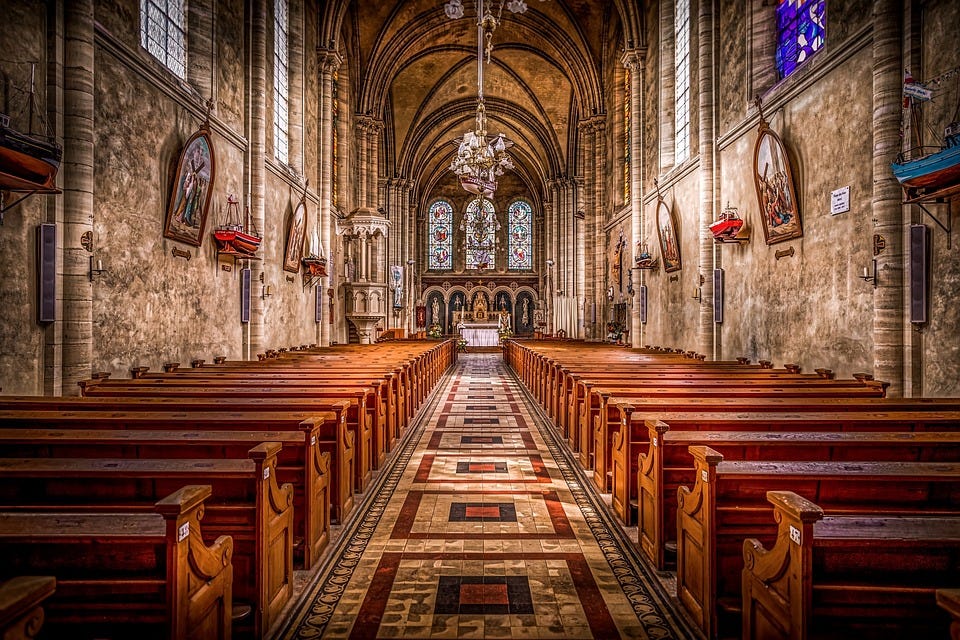The pomp and circumstance of Christianity has always baffled me. It is misunderstood from the outside. It’s absurd that a religion could grow that fast, through such vast swaths of land. It got certain things right. This article, will try to touch upon it.
Sitting in contemplation
One aspect of many religions is the mystical experiences, or mysticism. The practice of religious ecstasies, to find hidden inner truths. This can be by seeing of God, or Mary for example. They are often vaguely defined, and can seem quite strange if you aren’t religious. But, as Zen-buddhism teaches us, experiences can’t be transferred. Experiences can’t be put into words. That’s one of the many causes why these religious happenings are so misunderstood. I think I’ve had some of these experiences in my lifetime, without knowing. At the time I had them, I was a hard-core atheist, but now, I think there is more.
One can debate the positive effects of these experiences, but mostly they’re a waking up experience. They teach life lessons and give something deeper in return. Intellectual debate can certainly be interesting, up to a certain point. After that, one has to leave the words behind, to reach something higher. The things that can’t be forced into words, that one just feels. In the same way, words reduce religion to something it is not. As Karen Armstrong notes, religion as a concept didn’t exist. Religion was life. It pervaded everything, there was nothing without it.
A good example of this are the Mary Apparitions. It is something I cannot wrap my head around. It’s incredible that so many of these apparitions happened. Here a map. Even from a materialist (life is only brain matter) standpoint, they are wonderful. One of the most notable ones are the apparitions of Fatima, Portugal. Mary appeared 6 months in a row, the last of which 30,000 people stood and watched. These events invoke many pilgrimages.
Marian apparitions (National Geographic)
The Icons are another example. They are the materialisation of Christ, Mary, saints and angels. Often very ornamented in Gold, they are said to make it easier for people to recreate the mystical experiences (Karen Armstrong- History of God). It’s the same theme over and over again. One cannot explain these in words, but they exist.
Icons
Aesthetics
Okay, after a long venture, let’s come back to Catholicism. And especially aesthetics.
Catholicism makes it easier to evoke these experiences. Not only mystical, but of wonder, connectedness. Catholicism touches upon deep human aspects of long-term happiness. Let me explain.
Traditional Christianity (pre-Vatican II) puts a heavy focus on the spirituality and beauty. Protestantism removed beauty. In our modern society, there’s little beauty, only fashion. Spirituality, just as aesthetics is a skill, which can be developed. The more one is exposed to beauty, the quicker one recognises it. And with beauty, I mean real beauty. Examples of these are buildings that stand the test of time. Such as the Hagia Sophia, or the Sainte-Chapelle.
Sainte Chapelle
An example are the places of worship, compare the famous French cathedrals, to the stripped down versions of Protestantism. The stained glass, the intricate patterns, the structure of the building itself (focus on tabernacle), candles… I’m missing a lot of the elements. All make a unity in dedication to God. They are an (imperfect) representation of God itself. The cathedrals, and churches touch something deeply human. They convey eternality. This stands in contrast to the modern world, where everything is fleeting.
Another example are the Gregorian Chants. Surrounded by beauty, you cannot feel anything but reverence. The place demands it of you, just gently. The Gregorian chants are just sung by men. Combined with the architecture and liturgy in Latin, they awaken something deep, something you didn’t know was inside you. The way the Mass was meant to be celebrated. Organs are also a divine addition.
I would even go so far as to say that spoken latin is more beautiful than an ordinary vernacular spoken mass. There’s more veneration and beauty in it.
The mind can be trained to appreciate these things. If you trust (credere in latin, means believing and trusting), good things will befall upon you.
Beauty and remembering
Form is function. Why? Beauty is something that invokes happiness in a human brain. Without beauty, one can’t live a normal life.
Apart from this function, christian beauty is also memory. Bible verses had to be remembered. The beautifully ornamented bibles also serve as a memory device. Every page is different, so that you can orientate yourself. They are not only very beautiful, they also serve a practical function. Forgetting this particular page is impossible.
Conclusion
Christianity nails a few aspects quite right. By removing these, it becomes a hollow shell. There are so many reasons it works… I’ve barely scratched the surface, hopefully, I can convey it to you all.
I’ve written on the removal of ornaments before. This article expands on what exactly happened in the church. Thank you for the great many responses! The Inner Destruction of the Church.
And don’t forget to subscribe if you want to see more.
If you want to see more of me, follow me on Twitter. Don’t hesitate to send me a message, if you’ve appreciated what I’ve read. On the account, I try to remind you how beautiful art (and especially Stained Glass is).








